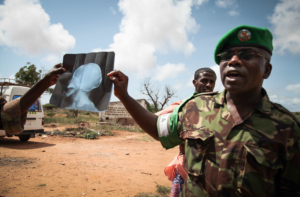Mobile Clinics in Kenya Bring Health Care to the Masai Village
 Located on the east coast of Africa, Kenya is a country of mountains, lakes, savannahs and the Great Rift Valley. With more than 50 million people, Kenya is expected to see a 51% population increase in the next 25 years. Despite this steady growth, the country’s life expectancy remains 66 years—about five years below the global average. HIV/AIDS and tuberculosis are the leading causes of death in Kenya. To curb the spread of these diseases, local governments and organizations have introduced mobile medical care to improve access to health screenings, treatments and health care services.
Located on the east coast of Africa, Kenya is a country of mountains, lakes, savannahs and the Great Rift Valley. With more than 50 million people, Kenya is expected to see a 51% population increase in the next 25 years. Despite this steady growth, the country’s life expectancy remains 66 years—about five years below the global average. HIV/AIDS and tuberculosis are the leading causes of death in Kenya. To curb the spread of these diseases, local governments and organizations have introduced mobile medical care to improve access to health screenings, treatments and health care services.
Targeting HIV/AIDS
A global health issue, the human immunodeficiency virus (HIV) is a virus that attacks the body’s immune system, with acquired immunodeficiency syndrome (AIDS) occurring when the virus advances. More than 40 million people have died of HIV/AIDS globally.
In August 2024, the Military Health and Research Program (MHRP) reported collaborating with local government entities to bring HIV preventative measures and treatment to Masai village in Kenya’s South Rift Valley Region. To bring care to this rural area, the MHRP developed a mobile clinic that could get health care to those who could not access it otherwise.
Utilizing funding from the United States of America’s President’s Emergency Plan for AIDS Relief (PEPFAR), the mobile clinic in Kenya provides patients with HIV testing, preventative education and antiretroviral therapies for those who test positive.
Fighting Tuberculosis
In addition to providing HIV/AIDS treatment, mobile clinics in Kenya also focus on tuberculosis, the leading cause of death among men in the country. This infectious, airborne disease claimed more than one million lives in 2023 alone. Babies, children, malnourished individuals and people with diabetes face a higher risk of contracting tuberculosis. While the disease is both preventable and treatable, many lack access to education about prevention and treatment. Mobile clinics in Kenya are working to bridge this gap and improve health care access.
Before the arrival of the mobile clinic in Masai village, individuals infected with tuberculosis were treated in Tanzania, where there were no closer resources. The MHRP reports that treatment took six months and if an individual died in Tanzania, they were left there. Since the mobile clinic arrived, Masai village had seen no tuberculosis-related deaths for more than a year at the time of the report.
Maurice’s Account
In 2023, the Henry M. Jackson Foundation Medical Research International (HJFMRI) spoke to an individual from Masai village. Maurice, the individual living in the town, acknowledges the benefits of mobile clinics. He explains to HJFMRI that those sent to Tanzania for treatment before the mobile clinics had to walk there on an eight-day trek. Maurice says he and the others from his village are “so happy” and “grateful” for the PEPFAR initiative that allowed the mobile clinics.
Beyond Masai Village
Mobile clinics in Kenya extend well beyond Masai village. CURE, Kenya’s children’s hospital, operates multiple mobile clinics nationwide, bringing health care directly to people where they “work, live and play.” Mobile clinics give health care access to individuals who otherwise have little to none. With funding from PEPFAR and the efforts of MHRP, local governments and other private agencies, mobile clinics bring care to many people in Kenya and work to combat the global health issues of HIV/AIDS and tuberculosis.
– Hannah Pacheco
Hannah is based in Boston, MA, USA and focuses on Good News and Global Health for The Borgen Project.
Photo: Flickr
